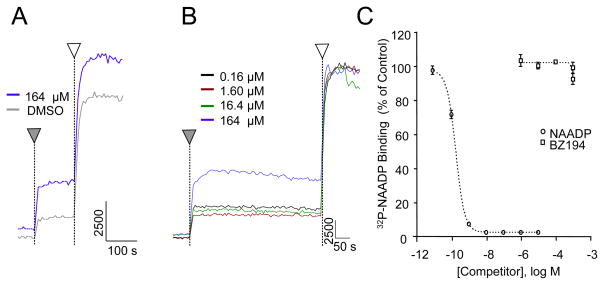Figure 7.
Characterization of the antagonist activity of BZ194 on NAADP induced Ca2+ release (A, B) and on competition ligand binding activity (C) in Strongylocentrotus purpuratus egg homogenates. (A, B) Fluorometric Ca2+ release traces from sea urchin egg homogenates treated by the addition of DMSO alone or by varying concentrations of BZ194 dissolved in DMSO (▼), according to the procedure of Aarhus et al. [36]. This treatment was followed by the addition of a saturating concentration of NAADP (1 μM) (□). Panel A compares the results obtained with the vehicle DMSO alone with that obtained by adding 164 μM BZ194 as a solution in DMSO. Panel B shows the result of a concentration response study in which the BZ194 concentration was varied. The apparent Ca2+ mobilization at high BZ194 concentration is likely due to small amounts of Ca2+ contamination in the antagonist since in no case did we observe significant inhibition of the maximal NAADP-induced Ca2+ release. (C) The competition radioligand binding curve for NAADP and BZ194 in sea urchin egg homogenates. The ability of NAADP (○) or BZ194 (▫) to compete with [32P]NAADP for specific binding to sea urchin microsomes was determined according to the procedure of Aarhus et al. [36].

